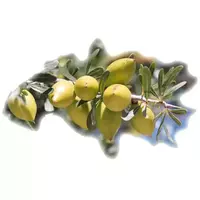Argania spiny

We think many have heard about the miraculous healing properties of argan oil. This product has enjoyed unprecedented popularity recently. However, few people know at least a little about a tree called argania or Argania, which by the way is considered the main breadwinner of the entire Berber tribe, which lives in North Africa. The branches of Argania are used by the natives in the construction of their adobe dwellings. Argania wood is used as firewood, and argania seed oil has long been considered the main medicine of African traditional medicine.
The argania tree belongs to the Sapota family of plants and is represented by only one species of spiny argania or Argania spinosa. The birthplace of Argania prickly is considered to be Morocco, as well as Algeria, where the tree grows. Usually spiny argania does not exceed 10 meters in height. The uniqueness of the plant lies in the fact that the argania tree can grow and bear fruit for at least 150 years. Argania refers to important plants for the African region. It's all about the extraordinary beneficial properties of the fruit of the plant.
The fruits of argania spiny somewhat resemble yellow plums. Usually argania fruits have an oval shape. Inside the barbed argan fruit is a core or nut, from which priceless argan oil is extracted. The main feature of argania fruits can be considered the chemical composition of nuclei or nuts of the plant. Aragon seeds contain an incredible amount of useful natural fatty amino acids. Some of them are considered indispensable for the human body. The pulp of argania fruits is not eaten.
This is due primarily to the fact that the contents of the aragnia fruits exude a fetid and unpleasant smell. Usually, argan oil is consumed, which is considered one of the most useful vegetable oils. Researchers claim that in the old days, argania trees grew not only in Morocco and Algeria. The plant was widely distributed throughout the southern regions of Europe and throughout North Africa. There are several unique features in the structure of the Argania tree.
For example, the entire plant is covered with thorns, which on the one hand protect the tree from insects and other animals that want to feast on fruits, as well as argan foliage. In addition, in order for the fruits of argania to be fully ripe and ready for processing, you need to wait for a whole calendar year. For this reason, the production of argan oil is quite long, painstaking and expensive.
True, for the sake of fairness, it is worth noting that argan oil brings invaluable benefits to the health of the human body, therefore, in this case, the end fully justifies all means of achieving it. Taking into account the importance of the Argania tree for the people of the African continent, UNESCO has declared the territory of plant growth in Morocco a biosphere reserve under international protection.
barbed arganium 295 kCal
The energy value of spiny arganias (Ratio of proteins, fats, carbohydrates - ju):
Proteins: 0.1 g (~ 0 kCal)
Fats: 0.1 g (~ 1 kCal)
Carbohydrates: 0.1 g (~ 0 kCal)
Energy ratio (b | y): 0% | 0% | 0%
 Español
Español Français
Français Português
Português Русский
Русский 简体中文
简体中文 繁體中文
繁體中文 日本語
日本語 한국어
한국어 العربية
العربية Türkçe
Türkçe Қазақ
Қазақ Deutsch
Deutsch Italiano
Italiano Українська
Українська
